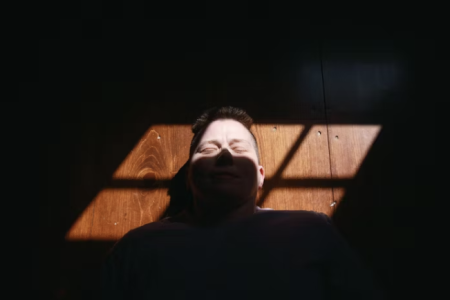Tossing and turning? This doctor-backed method might finally help
- Replies 1
Before we dive into the method, let’s talk about sleep latency, the term for how long it takes you to fall asleep after you lie down and turn off the lights.
According to the Sleep Foundation, a healthy range is 10 to 20 minutes.
But for many, this number stretches far longer—thanks to stress, anxiety, or an overactive brain that won’t hit the brakes.
If you find yourself watching the minutes tick by in frustration, it may be time to try something new.
Dr. Joe Whittington, an emergency physician and popular social media user, has introduced a method called the Infinity Tracing Technique—and it’s delightfully simple.
It requires no medication, no apps, and no fancy equipment. Just your finger, your eyes, and a little focus.
Here’s how to do it:

Dr. Joe explains that this technique activates the vestibular center of your brain—the part that helps regulate balance and eye movement.
By gently engaging this area, you create a mild distraction that shifts focus away from racing thoughts.
Think of it like giving your brain a soothing visual lullaby—calming the chaos with just a finger’s motion.
Viewers familiar with therapy techniques quickly noted a similarity between Infinity Tracing and EMDR (Eye Movement Desensitization and Reprocessing), a method used to treat PTSD.
EMDR also uses eye movements to help the brain process and regulate emotions.
While Dr. Joe’s technique isn’t a clinical therapy, it does appear to borrow from the same calming science.
And for those simply trying to fall asleep faster, it’s a gentle, no-risk trick worth exploring.
As we age, sleep often becomes more fragile.
Medications, health issues, and changes in circadian rhythm can all affect our ability to drift off and stay asleep.
That’s why safe, non-pharmaceutical techniques like this one are so valuable—they’re easy to try, cost nothing, and can be done anywhere.
If you’re seeking better rest without sleeping pills or supplements, Infinity Tracing might be just the ticket.
The next time your brain feels too busy to sleep, give this method a go.
It takes just seconds to start and requires no setup at all.
Many who’ve tried it report falling asleep faster and feeling calmer before bed.
Even if it doesn’t work right away, it can become part of a soothing nighttime routine.
Read more:
 Have you tried Dr. Joe’s technique—or do you have your own go-to methods for drifting off? We’d love to hear what works for you. Leave a comment below and help fellow readers get the rest they deserve.
Have you tried Dr. Joe’s technique—or do you have your own go-to methods for drifting off? We’d love to hear what works for you. Leave a comment below and help fellow readers get the rest they deserve.
According to the Sleep Foundation, a healthy range is 10 to 20 minutes.
But for many, this number stretches far longer—thanks to stress, anxiety, or an overactive brain that won’t hit the brakes.
If you find yourself watching the minutes tick by in frustration, it may be time to try something new.
Dr. Joe Whittington, an emergency physician and popular social media user, has introduced a method called the Infinity Tracing Technique—and it’s delightfully simple.
It requires no medication, no apps, and no fancy equipment. Just your finger, your eyes, and a little focus.
Here’s how to do it:
- Get comfortable in bed, with the lights off and the room quiet.
- Raise a finger in front of you and slowly trace an infinity symbol (∞) in the air.
- Keep your head still and follow the motion only with your eyes.
- Repeat this motion at a calm, steady pace until your mind begins to relax.

Dr. Joe Whittington recommends the “Infinity Tracing Technique” to help calm an overactive brain and aid in falling asleep. Image source: Shane / Unsplash
Dr. Joe explains that this technique activates the vestibular center of your brain—the part that helps regulate balance and eye movement.
By gently engaging this area, you create a mild distraction that shifts focus away from racing thoughts.
Think of it like giving your brain a soothing visual lullaby—calming the chaos with just a finger’s motion.
Viewers familiar with therapy techniques quickly noted a similarity between Infinity Tracing and EMDR (Eye Movement Desensitization and Reprocessing), a method used to treat PTSD.
EMDR also uses eye movements to help the brain process and regulate emotions.
While Dr. Joe’s technique isn’t a clinical therapy, it does appear to borrow from the same calming science.
And for those simply trying to fall asleep faster, it’s a gentle, no-risk trick worth exploring.
As we age, sleep often becomes more fragile.
Medications, health issues, and changes in circadian rhythm can all affect our ability to drift off and stay asleep.
That’s why safe, non-pharmaceutical techniques like this one are so valuable—they’re easy to try, cost nothing, and can be done anywhere.
If you’re seeking better rest without sleeping pills or supplements, Infinity Tracing might be just the ticket.
The next time your brain feels too busy to sleep, give this method a go.
It takes just seconds to start and requires no setup at all.
Many who’ve tried it report falling asleep faster and feeling calmer before bed.
Even if it doesn’t work right away, it can become part of a soothing nighttime routine.
Read more:
- Falling asleep too quickly? Experts reveal a serious health risk you need to know about
- Is your partner ruining your sleep? Try this simple trick to save your relationship AND your sleep!
Key Takeaways
- Dr. Joe Whittington recommends the “Infinity Tracing Technique” to help calm an overactive brain and aid in falling asleep.
- The technique involves tracing the infinity symbol with a finger while following the movement with one's eyes.
- This helps activate the vestibular centre, which is linked to balance and eye movements, potentially calming racing thoughts.
- Some commenters have likened the technique to EMDR therapy, which is used to treat PTSD.






